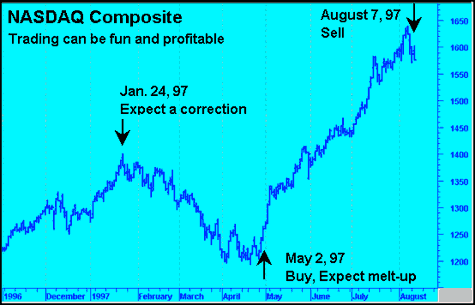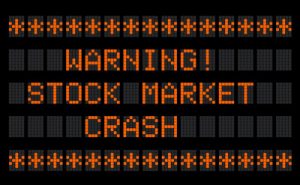The Early Years of Dohmen Capital’s Market Calls

When the market topped out and reversed direction on April 23rd, 1998, a “sell” signal was issued by Bert Dohmen, the founder of the award winning Bert Dohmen’s WELLINGTON LETTER.
Commentary on June 16, 1998: “The way the blue chips were kept down today while the rest of the market was strong is indicative of a short-term bottom. As you can see everything is being engineered for a good rally the rest of the week.”

Recommendation made on July 11, 1997: “Fixed income investors should consider the Zero Coupon mutual funds, such as the Target Funds offered by the American Century Mutual Fund Group. The Zero Coupons are in effect a leveraged play on long-term U.S. Treasury Bonds. A gain of 50% over the next 3 years is probable..

On August 17, 1998 Russia defaulted on its international debt. It shocked the global financial markets. Dohmen’s technical work had given him a “sell” and “sell short” signal on July 23, about three weeks earlier. Here you can see that the big money knew what was happening. The money flow, measured by advanced technical analysis, showed that big money flows had reversed from in, to out, producing the timely sell signal. Here is the chart:
And when the big money saw that international efforts to resolve the crisis would work, they plunged back into the market in September-October at much lower prices. Again, advanced technical analysis allowed Dohmen to give very timely “buy” signals.
Simply put, you need to know what to do, and when to do it. If you want to significantly improve your investment performance, perhaps it’s time to take advantage of the timing strategy of these Bert Dohmen services.

On January 24, 1997, Bert Dohmen declared that a short term market top had just been made and that even if the blue chip indices made a slightly higher high over the subsequent weeks, the broad market should undergo a strong correction. As it turned out, January 22 was a short term top in the broad market. The correction in many sectors was severe over the next 3 months.
On May 2, 1997, Bert Dohmen issued a fax alert to subscribers to immediately get fully invested. He declared that a “melt-up”, rather than a “melt-down” predicted by the bears, would occur.
An Unmatched Track Record For Over 40 Years
With over four decades of investing experience and publishing the award-winning Wellington Letter, Bert Dohmen has refined his predictive models to pin-point changes in the markets. Many of his predictions were totally out of line with the advice being given at the time. Yet, he was proven right time and time again. Here are just a few of his calls over the years:
1977 – 1989
Dohmen predicted the 1977-78 stock bear market, which lasted 15 months. He also forecasted the roaring bull market in gold, which peaked at $850 an ounce in 1980.
He was one of the handful of analysts to forecast a then-unbelievable 21% prime rate. The rate was only 11.5% at the time. Yet in 1980, the prime rate reached 21.5%.
He predicted the deep recession, the spirited recovery and the Reagan economic boom of the mid-1980s.
Bert Dohmen forecasted that the Dow would reach 3400-3600 by the early 1990s. His prediction was right on target.
Bert issued a “buy” recommendation on stocks, and in an interview with Business Week, projected a target of 2700 for Dow Jones Industrials in 1987. The Dow reached Bert’s 2700 target in August 1987, peaking at 2722.
His company which offered managed accounts sold heavily and went down to a 23% invested position. The possibility of crash loomed, according to Dohmen. That happened on Oct. 19, when the DJI lost over 22% in one day.

The day of the crash, Dohmen issued a Special Bulletin, predicting that the next day would be the low of the crash, presenting superb bargain hunting opportunities. He advised “It’s still a bull market.” As we know now, it was a superb buying opportunity.
Bert Dohmen warned in a Special Bulletin to sell. Two weeks later, the Dow started a 300 point plunge.
1990 – 1993
Bert said, “Time to sell Japan.” The best-known fund, GT Japan Growth, lost 48.2% in the following 3 years. Then, in December of 1992, Bert recommended buying back into Japan funds, and the GT fund has gained 49.6% since that “buy” signal.
Dohmen announced that a recession had started. A year later the National Institute for Economic Research confirmed that the recession began in June 1990, just as he had pinpointed. None of the well-known forecasters had recognized it. In fact, the head of the Federal Reserve told a Congressional committee: “there is no recession in sight.”
Bert pinpointed the market top at 3000 and gave a total “sell” signal on stocks FIVE days before the Dow began a 650-point decline.
He issued a “buy” signal on biotech funds. Oppenheimer Global Biotech then proceeded to explode upwards, gaining 179.3% from his “buy” signal to his “sell” signal in January of 1992.
He issued a “sell” signal on all Health/Biotechnology funds on the exact day of the top in this sector. Over the next five months, this sector declined 40%. In May 1992, Bert said, “Regional bank mutual funds are the next hot area.” Fidelity’s Select Fund has since gained 52.5%.
Bert recommended precious metals, such as Lexington Strategic Investments Fund. The fund was up 267% in 18 months.
Dohmen advised “exiting all U.S. income funds now.” In the ensuing 12 months, bond funds lost 23.8%, the worst 12 month performance in U.S. bond history.
1994 – 1996
Hong Kong and China investments were hyped by Wall Street in 1993. Bert gave a sell signal on the emerging markets, including Hong Kong and China. In early February, the mainland Chinese markets crashed 80% to 90%. Bert’s clients were safe once again.
Bert Dohmen recommended exiting the U.S. equity market. By late September, 75% of all stocks on the NYSE had declined 20% or more from their peaks.
The derivative bubble burst in 1994 when the Federal Reserve tightened. Orange County, CA filed for bankruptcy. Clients of the major derivative player, Bankers Trust, sued the bank for multi-million dollar losses. Bert Dohmen had warned about the derivative bubble in late 1993.
Bert issued a sell signal on Mexico and Latin America. He had stayed out of those markets in 1994, but almost every Wall Street analyst had these markets on their buy list. Bert felt compelled to issue a strong sell. Several weeks later, Mexico crashed into a depression, dragging many Latin American markets with it. Mutual Funds investing in those areas declined 50% – 60%. Bert Dohmen’s clients were safe.
Bert Dohmen warned to get out of high technology stocks by the end of August. His analysis: Windows 95, the new program of Microsoft, had been hyped to the extreme. Computer manufacturers had double and triple ordered components, causing shortages. Everyone expected a huge influx of PC orders, in order to run the new Windows version.
But Bert Dohmen stated that businesses would not convert quickly, as their current software was running nicely on their current equipment. Therefore Windows 95 sales would be disappointing, and the anticipated PC boom would not occur. As we know now, he was right on target.
In the first week of September, the high tech boom fizzled, and many stocks lost 50%-70% over the next several months.
1996 Outlook issue, Bert Dohmen wrote: “…1996 will bring some exceptional opportunities for investors. There will be some sharp, scary corrections, but they will be brief. Each one will present a new buying opportunity”.
At that time, many Wall Street analysts were bearish, saying that a good year like 1995 could not be followed by another good year. They were wrong.
The market had an abrupt decline. Bert Dohmen goes by the theory that when the market does the opposite to what the indicators suggest, it’s time to pay attention. The next market day, Bert Dohmen recommended a list of high technology stocks to sell short. Over the next three weeks, as Wall Street was taken by surprise, and the technology and small company stocks plunged, SMARTE TRADER subscribers actually profited handsomely.
A high profile market analyst was featured on national television with a sharp change in her previously bullish forecast. She predicted that the market would decline another 20%-25%. Bert Dohmen took that as a signal for the bottom of the correction, and together with his other indicators, confirmed that a bottom was in place. Short positions were closed out, and new purchases were recommended. As we know now, the bottom presented a perfect buying opportunity, as the Dow Jones Industrials soared over 1,300 points going into the end of 1996.



